Thinking about those who suffer as a result of conflict
| |
Thank you for registering for this free Discovering God resource.
(Have you been sent this link by someone else? We'd be grateful if you could please register in your own right to use these resources. There is no charge to you, but it helps us to monitor takeup so that we can plan for the future. Thank you.)
|
|
Discovering God is a resource offering practical ideas for informal services and events. With a theme-based approach this series can help create community and a sense of belonging.
Guidance on using Discovering God can be found at: www.rootsontheweb.com/dg-intro
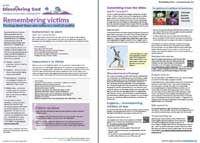
Click on the image to view a PDF.
Somewhere to start
Here’s a way to introduce the theme.
Place a large candle where everyone can see it. Ask for a volunteer to light it. Explain that you are lighting it in remembrance of all victims of war. Leave the candle burning throughout your time together. Also, ask people to draw a picture of a candle at this point.
Peace-loving God,
wars rage around the world.
It feels like there is never a moment of peace.
As we remember the victims of war,
we pray that your light would shine in the darkness,
bringing the hope of peace. Amen.
Somewhere to finish
Before you end, come together to gather your thoughts and, if appropriate, to pray.
Give each person a lit LED tealight (alternatively, if it is safe to do so, use real tealights and light them from the large candle). Invite everyone, while holding their tealight, to think about all that has been said and done in the session in relation to victims of war. After a short silence, ask people to place their tealight beside the large candle as an act of remembrance for all such victims. Then, if they wish, to pick one of the words of comfort to take home.
God of Peace,
we pray for those who are, or have been, caught up in conflict.
May they know your loving presence.
We lift to you those who have lost loved ones in conflict.
May they know your comfort.
We bring to you those who perpetrate violent conflict.
May they seek better ways to resolve differences.
We lift to you all who work to help those suffering in wars.
May you bless them and sustain them in their efforts.
We pray for ourselves.
May we see peace in our own relationships and communities. Amen.
Follow-up ideas
Follow the news over the next week and pray for those involved in stories of conflict you hear.
Make a poppy in any colour of your choice. You could use paper, card, wool, wood or another material – the only limit is your imagination!
Could you all work together to organise a short Act of Remembrance for the victims of war? What elements might this include? Are there songs, poems, prayers or activities that you would like to include? Where might it take place?
Something from the Bible
Isaiah 9.6-7 and Isaiah 2.4
The first of these Old Testament passages foresees the coming of a king – a ‘Prince of Peace’ whose rule will bring about an ‘endless peace’. A future in which there will be no victims of war because there will be no war. The second is a vision of a time when people no longer start wars, and instead, turn their weapons into farming tools; the implication being that they will spend their time peacefully producing food to sustain life instead of fighting each other to end it.
Read and share
Invite people to think of symbols of peace (use phones to search for ideas). Make simple paper crowns for a ‘Prince of Peace’. Decorate them with some of the symbols you have thought of. Then read Isaiah 9.6-7. Display an image of the sculpture ‘Let us beat Swords Into Ploughshares’ by Evgeny Vuchetich. Discuss together how it would feel to live in a world with no weapons. Then read Isaiah 2.4.
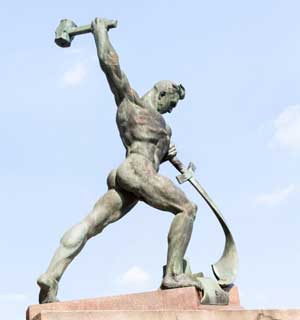 |
…‘they shall beat their swords
into ploughshares, and their
spears into pruning-hooks;
nation shall not lift up sword
against nation, neither shall
they learn war any more.’
Isaiah 2.4
Click on the image to view a larger version.
|
What could we learn from this passage?
Wars within and between countries often feel like something that we, as individuals, have little influence over. For Christians, Isaiah’s Prince of Peace is Jesus; his birth, life, death and resurrection are God’s way of turning Isaiah’s visions into reality. However, we don’t yet see the full outworking of this; so, we still experience war, violence and death. Yet we can all work to take steps towards the peaceful world that God intends for us. And, choose to work actively for peace in our friendships, families and communities. This leads us to ask: How can we mange conflict in our relationships well? What can we do to help ensure there is understanding and friendship between different groups of people in our communities? How can we celebrate the differences between us and those we interact with?
Explore... remembering victims of war
Choose from these ideas to help people of all ages explore the theme together. Use the spiritual styles indicated by the coloured letters to help you plan, and cater for the different ways in which people connect with God.
Poppies in many colours W E A
Look together at this article which explains four different poppies worn in the lead up to Remembrance Day in the UK.
Discuss these questions together:
- Do you wear any of these poppies? Why/why not?
- Can you list some of the groups of people/animals who are victims in war?
- Do you think we should remember victims from all sides of a conflict, rather than just our own? Why/why not?
- How do you feel about the idea that there are no heroes in war, only victims? Why do you think we might sometimes prefer to think of those lost in war as heroes?
- Are there stories from past or current wars and conflicts, or groups of people involved in those wars, that are important to you but don’t get much coverage in the media or in education?
NB People have very personal reasons for wearing or not wearing a poppy, and for their choice of colour. Encourage everyone to respect the views of others. It may be helpful to refer to the Royal British Legion website: ‘Wearing a poppy is never compulsory… when and how you choose to wear a poppy is a reflection of your individual experiences and personal memories.’
The significance of a wildflower for Remembrance
|
 |
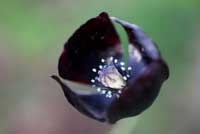 |
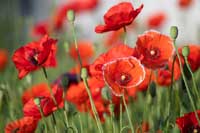 |
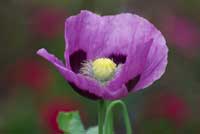 |
| Click on an image to view a larger version. |
Newspapers into cranes W A
Read a newspaper article about a current armed conflict. Discuss who the victims are and in what ways they are suffering. Give each person a page of a newspaper and invite them to turn it in a paper crane (instructions). This is a symbol of peace in Japan. Consider donating to a fund which supports the victims of current conflicts, e.g. the Disasters Emergency Committee.
Praying for victims W S
You will need: paper, in two different colours (you could ask people to cut them into the shapes of poppies or hearts). Invite people to take a piece of paper in each colour. On one colour, ask them to write victims of war – this could be individuals they know personally or through the media, or it could be larger or more general groups of people affected by conflicts, such as communities or countries.
Encourage people to think of those who have died, and those still living and still suffering as a result of war – e.g. those who have sustained life-changing injuries, or who lost a loved one, or were forced to leave their home. On the other colour, invite people to write words of comfort – a single word or a sentence or two. Ask them to place both of their papers around the large lit candle, as an act of prayer.
Build a memorial W S
Provide building blocks or Lego™ for people to make their own memorial for victims of conflict. Ask anyone who is happy to do so, to show their memorial and share why they made it the way they did.
‘Tis sweet and fitting? W E
Read the poem Dulce et Decorum Est by Wilfred Owen. Owen suggests that Dulce et decorum est Pro patria mori (‘Tis sweet and fitting to die for one’s country’) is a lie.
- Do you agree or disagree with him?
- How does this poem make you feel – about war, about heroes, about victims?
- What do you think God wants, and what can we do to achieve that?
- How do we start to build peace?
| |
W E S A
|
|
Spiritual styles key
Word, Emotion, Symbol, Action
Look out for opportunities to weave different Spiritual styles into your plan.
|
|
| |
All references to spiritual styles refer to the work of David M Csinos in his book Children's Ministry that Fits, published in 2011 by Wipf and Stock. Find out more here
|
|